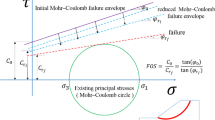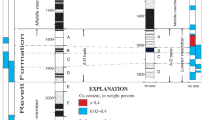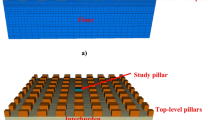Abstract
The objective of this paper is to evaluate the performance of pillars located on level #3 at Nohyun limestone mine that uses the room-and-pillar method. The mine is located at South of Cheongju city, North Chungcheong Province, South Korea. A series of two-dimensional elasto-plastic finite-difference models has been constructed using FLAC2D software. Factor of safety (FOS) is then calculated using fish-code (“solve FOS”), an internal command of FLAC built on a shear strength reduction technique. The results are presented and discussed in terms of stress state, deformation, and factor of safety with respect to mining sequence, mining depth, and mineshaft width. The results reveal that the stability of pillars deteriorates when level #3 is entirely mined out after extracting level #2 (i.e., FOS = 1.33 to 1.55). In addition, the safety of pillars is sharply dropped (i.e., FOS = 1.16 to 1.33) when mining depth extends to 15 m; and similarly, width of mineshaft increases by 2 m. Also, a comparison of calculation of safety factor, FOS, employing numerical modelling (i.e., FOS = 1.16 to 1.86), and analytical methods (i.e., FOS = 7.35 to 36.36) has revealed that numerical modelling is more conservative from a design point of view. The study also indicates that the overall mine stability is influenced by the discordance in the pillar arrangement between adjacent levels. Therefore, it is recommended that the pillar design should be dictated by the inclination of the orebody.





























Similar content being viewed by others
References
Bieniawski ZT (1967) Discussion- a study of the strength of coal pillars by M.D.G. Salamon and A. H. Munro. And a method of designing bord and pillar workings by M. D. G. Salamon. J South Afr Inst Min Metall 68(2):185–199
Bunting D (1991) Chamber pillars in deep anthracite mines. Trans AIME 42:236–245
Chikande T, Zvarivadza T (2016) Review of support systems used in poor ground conditions in platinum room and pillar mining: a Zimbabwean case study. J South Afr Inst Min Metall 116:323–332
Choi SO, Kim BR, Son H (2017) Analysis of safety pillar stability considering weathering characteristics of rock in underground limestone mine. 4th ISRM Young Scholars Symposium on Rock Mechanics, Jeju, Korea, pp 10–13
Choochang S-N (2013) Room and pillars design for Phetchaboon coal mine project. M. Eng. Thesis, Suranaree University of Technology, Nakhon Ratchasima, Thailand
Clarke BG Welford M, Hughes DB (2006) The threat of abandoned mines on the stability of urban areas. IAEG2006, Nottingham, United Kingdom, 6-10 September 2006. Available online: http://iaeg2006.geolsoc.org.uk/cd/papers/iaeg_379.pdf. Accessed 18 Nov 2016
Dehghan S, Shahriar K, Maarefvand P, Goshtasbi K (2013) 3-D numerical modelling of Domino failure of hard rock pillars in Fetr6 Chromite Mine, Iran, and comparison with empirical methods. J Cent South Univ 20:541–549
Esterhuizen GS (2007 Jan) Evaluation of the strength of slender pillars. Trans Soc Min Metall Explor 320:69–76
Esterhuizen GS, Iannacchione AT, Ellenberger JL, Dolinar DR (2006) Pillar stability issues based on a survey of pillar performance in underground limestone mines. 25th International Conference on Ground Control in Mining, Morgantown, WV, pp 354–361
Esterhuizen GS, Dolinar DR, Ellenberger JL, Prosser LJ, Iannacchione AT (2007) Roof stability issues in underground limestone mines in the United States. Proceedings of the 26th International Conference on Ground Control in Mining, Morgantown, WV, pp 320–327
Esterhuizen GS, Dolinar DR, Ellenberger JL (2008) Pillar strength and design methodology for stone mines. In: Peng SS, Tadolini SC, Mark C, Finfinger GL, Heasley KA, Khair AW, Luo Y, eds. Proceedings of the 27th international conference on ground control in mining. Morgantown WV: West Virginia University. p. 241–253.
Fahimifar A, Oreste P, Ranjbarnia M (2013) The dimensioning of pillars in the mining rooms and pillars method through a detailed evaluation of the stress conditions in the rock. Adv Environ Geol Sci Eng, pp.68-77. Available at http://www.wseas.us/e-library/conferences/2015/Salerno/EG/EG-07.pdf
Gaede O, Schrank C, Canbulat I, Karrech A (2014) A strain-based failure criterion for pillar stability analysis. AUSROCK 2014: Third Australasian ground control in mining conference, Sydney, NSW, pp 5–6
Guy R, Kent M, Russell F (2017) An assessment of coal pillar system stability criteria based on a mechanistic evaluation of the interaction between coal pillars and the overburden. Int J Min Sci Technol 27:9–15
Hedley DGF, Grant F (1972) Stope-and-pillar design for the Elliot Lake Uranium Mines. Bull Can Inst Min Metall 65:37244
Hosseini N, Oraee-Mirzamani B, Oraee K (2012) The Evaluation of Empirical Coal Pillar Strength Formula Based on Uncertainty Criterion. In Proceedings of the Thirty First International Conference on Ground Control in Mining, West Virginia
Idris M, Saiang D, Nordlund E (2015) Stochastic assessment of pillar stability at Laisvall mine using Artificial Neural Network. Tunn Undergr Space Technol 49:307–319
Jessu KV, Spearing A, Shafiezadeh M (2018) Laboratory and numerical investigation on strength performance of inclined pillars. Energies 11(11):3229. https://doi.org/10.3390/en11113229
Kendorski, F.S., (2007), , Proceedings, 26th International Conference Ground Control in Mining, Morgantown, WV, pp 298-303.
Kimmelmann MR, Hyde B, Madgwick RJ (1984) The use of computer applications at BCL Limited in planning pillar extraction and design of mining layouts. In: Brown ET, Hudson JA (eds) Proceedings of ISRM Symposium: Design and Performance of Underground Excavations. British Geotechnical Society, London, p 53263
Kortnik J (2015) Stability assessment of the high safety pillars in Slovenian natural stone mines. Arch Min Sci 60(1):403–417
Krauland N, Soder PE (1987) Determining pillar strength from pillar failure observations. Eng Min J 8:34240
Mete Kun, Baran Tufan, Nejat Kun (2014) The applicability of underground mining methods in limestone quarries of Western Taurus. Proceedings of the International Conference on Mining, Material and Metallurgical Engineering Prague, Czech Republic, Paper No. 61. Paper can be found at https://avestia.com/MMME2014_Proceedings/papers/61.pdf
Li C, Xu J, Wang Z, Qin S (2013) Domino instability effect of surrounding rock-coal pillars in a room-and-pillar gob. Int J Min Sci Technol 23:913–918
Lunder PJ (1994) Hard rock pillar strength estimation and applied empirical approach. M. Sc. thesis of applied sciences. Department of Mining and Mineral Process Engineering, University of British Columbia, Vancouver, Canada
Lunder PJ, Pakalnis R (1997) Determining the strength of hard rock mine pillars. Bull Can Inst Min Metall 90:51–55
Luo Y (2015) Room-and-pillar panel design method to avoid surface subsidence. Min Eng 67:105–110
Ma H, Wang J, Wang Y (2012) Study on mechanics and domino effect of large-scale goaf cave-in. Saf Sci 4:689–694
Martin CD, Maybee WG (2000) The strength of hard-rock pillars. Int J Rock Mech Min Sci 37:1239–1246
Mathey M, Van der Merwe JN (2016) Critique of the South African squat coal pillar strength formula. J South Afr Inst Min Metall 116:291–299
Obert L, Duval W (1967) Rock Mechanics and the Design of Structure in Rock, vol 650. Wiley, New York, NY
Peng SS (2007) Ground control failures: a pictorial view of case studies. West Virginia University Press, Morgantown, WV, USA
Potvin Y, Hudyma MR, Miller HDS (1989) Design guidelines for open stope support. Bull Can Min Metall 82:53262
Poulsen BA, Shen B (2013) Subsidence risk assessment of decommissioned bord-and-pillar collieries. Int J Rock Mech Min 60:312–320
Sahu P, Lokhande RD (2015) An investigation of sinkhole subsidence and its preventive measures in underground coal mining. Procedia Earth Planet Sci 11:63–75
Salamon MDG, Munro AH (1967) A study of the strength of coal pillars. J South Afr Inst Min Metall 68:55–67
Shao XP, Shi PW, Wang HX (2009) Study on pillars stability by keeping water in strip mining for small and medium-sized mines in northern Shanxi Province. Coal Technol 28:58–61 In Chinese
Sjöberg J (1992) Failure modes and pillar behaviour in the Zinkgruvan mine. In: Tillerson JA, Wawersik WR (eds) Proceedings of 33rd U.S. Rock Mechanics Symposium, Sante Fe. A.A. Balkema, Rotterdam, p 4912500
Tzalamarias M, Tzalamarias I, Benardos A, Marinos V (2018) Room and pillar design and construction for underground coal mining in Greece. Geotech Geol Eng 37:1–14. https://doi.org/10.1007/s10706-018-0717-2
Ünlü T (2001) Critical dimension concept in pillar stability. In: Proceedings of th 17th International Mining Congress and Exhibition of Turkey, pp 341–347. Paper can be accessed at http://www.maden.org.tr/resimler/ekler/52575f59148e0a9_ek.pdf
Yang HS, Kim WB, Ali MA (2012) Performance of pillar design in underground stone mines that include discontinuities. Geosystem Engineering, 15:3 187-194, https://doi.org/10.1080/12269328.2012.704160
Yu Y, Chen S, Deng K, Fan H (2017) Long-term stability evaluation and pillar design criterion for room-and-pillar mines. Energies 10:1644. https://doi.org/10.3390/en10101644
Author information
Authors and Affiliations
Corresponding author
Additional information
Editorial handling: Murat Karakus
Rights and permissions
About this article
Cite this article
Kim, JG., Abdellah, W.R. & Yang, HS. Parametric stability analysis of pillar performance at Nohyun limestone mine, South Korea—a case study. Arab J Geosci 12, 390 (2019). https://doi.org/10.1007/s12517-019-4550-6
Received:
Accepted:
Published:
DOI: https://doi.org/10.1007/s12517-019-4550-6




